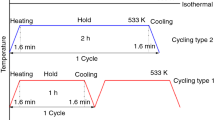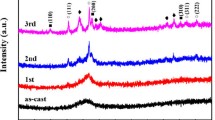Abstracts
Enthalpy recovery is not only an important characteristic of physical aging of glass, but also a good tool to investigate the physical aging. Using differential scanning calorimeter (DSC), the enthalpy recovery of Zr46.75Ti8.25Cu7.5Ni10Be27.5 bulk metallic glass (BMG) was studied. The typical characteristics of enthalpy recovery of glass including the sub-T g peak and ‘overshot’ were found in BMG. The evolution of the sub-T g peak and ‘overshot’ were described by the free volume theory and Hodge’s model, respectively. It was found that the former failed to describe the enthalpy recovery in the BMG, while the latter could give a qualitative explanation. In combination with the dynamics in the BMG, the origin of the enthalpy recovery in the BMG was discussed. The results show that BMGs are an ideal material to investigate the physical aging. The further understanding of physical aging of BMGs is useful to clarify the nature of glass and improve the application and device of new types of BMGs.
Similar content being viewed by others
References
Beck H, Güntherodt H J. Glassy Metals II. Berlin: Springer-Verlag, 1983. Chapter 6
Leutheusser E. Dynamical model of the liquid-glass transition. Phys Rev A, 1984, 29: 2765–2773
Torquato S. Glass transition: Hard knock for thermodynamics. Nature, 2000, 405: 521–523
Kovacs A J, Aklonis J J, Hutchinson J M, et al. Isobaric volume and enthalpy recovery of glass (II): A transparent multiparameter theory. J Polym Sci, 1979, 17: 1097–1162
Struik L C E. Physical Aging in Amorphous Polymers and Other Materials. Amsterdam: Elsevier, 1978
Hodge I M. Physical aging in polymer glasses. Science, 1995, 267: 1945
Hodge I M. Relaxation in Complex Systems. Washington, D.C.: Office of Naval Research, 1983. 65
Tool A Q, Eichlin C G. Variation caused in the heating curves of glass by heat. J Am Ceram Soc, 1931, 14: 276
Hodge I M. Enthalpy relaxation and recovery in amorphous materials. J Non-Cryst Solids, 1994, 169: 211
Cohen M H, Grest G S. Liquid-glass transition, a free volume approach. Phys Rev B, 1979, 20: 1077
Taso S S, Spaepen F. Structural relaxation of a metallic glass near equilibrium. Acta Metal, 1985, 33: 881
Chen H S, Inoue A, Masumoto T. Two-stage enthalpy relaxation behavior of (Fe0.5Ni0.5)83P17 and (Fe0.5Ni0.5)83B17 amorphous alloys upon annealing. J Mater Sci, 1985, 20: 2417
Donth E. The Glass Transition: Relaxation and Thermodynamics in Polymers: Glass Transition. Berlin Heidelberg: Springer-Verlag, 2001
Greer A L. Metallic glasses. Science, 1995, 267: 1947
Johnson W L. Bulk glass-forming metallic alloy: Science and technology. MRS Bull, 1999, 24(10): 42
Tang X P, Geyer U, Busch R, et al. Diffusion mechanisms in metallic supercooled liquids and glasses. Nature, 1999, 402: 160
Wen P, Zhao D Q, Pan M X, et al. Relaxation of metallic Zr46.75Ti8.25Cu7.5Ni10Be27.5 bulk glass-forming supercooled liquid. Appl Phys Lett, 2004, 84: 279
Meyer A, Busch R, Schober H. Time-temperature superposition of structural relaxation in a viscous metallic liquid. Phys Rev Lett, 1999, 83: 5027
Wen P, Johari G P, Wang R J, et al. Change in the vibrational properties in the metallic glass with time. Phys Rev B, 2006, 73: 224203
Yue Y, Angell C A. Clarifying the glass transition behavior of water by comparison with inorganic glasses. Nature, 2004, 427: 717
van den Beukel A, Sietsma J. The glass transition as a free volume related kinetic phenomenon. Acta Metall Mater, 1990, 38: 383
Bakke E, Busch R, Johnson W L. The viscosity of the Zr46.75Ti8.25Cu7.5Ni 10Be 27.5 bulk metallic glass forming alloy in the supercooled liquid. Appl Phys Lett, 1995, 67: 326
Kovacs A J, Aklonis J J, Hutchinson J M, et al. Isobaric volume and enthalpy recovery of glasses. 2. A transparent multiparameter theory. J Polym Sci Part B: Polym Phys, 1996, 34: 2467
Narayanaswamy O S. A model of structural relaxation in glass. J Am Ceram Soc, 1971, 53: 380
Hodge I M. Effects of annealing and prior history on enthalpy relaxation in glass polymer. 4. Comparsion of five polymers. Macromolecules, 1983, 16: 898
Angell C A, Borick S. Glass transitions and first order liquid-metal-to-semiconductor transitions in 4-5-6 covalent systems. J Non-Cryst Solids, 2002, 307–310: 393
Kubaschewski O, Alcock C B, Spencer P J. Materials Temochemistry. 6th ed. New York: Permagon, 1993
Debenedetti P G, Stillinger F H. Supercooled liquids and the glass transition. Nature, 2001, 410: 259
Tanaka H. Origin of the excess wing and slow β relaxation of glass formers: A unified picture of local orientational fluctuations. Phys Rev E, 2004, 69: 021502
Author information
Authors and Affiliations
Corresponding author
Additional information
Supported by the National Natural Science Foundation of China (Grant No. 50671118)
Rights and permissions
About this article
Cite this article
Wen, P., Zhao, Z. & Wang, W. Physical aging in Zr46.75Ti8.25Cu7.5Ni10Be27.5 typical bulk metallic glass manifested as enthalpy relaxation. Sci. China Ser. G-Phys. Mech. As 51, 356–364 (2008). https://doi.org/10.1007/s11433-008-0048-z
Received:
Accepted:
Published:
Issue Date:
DOI: https://doi.org/10.1007/s11433-008-0048-z




